#neoclassical dress
Text
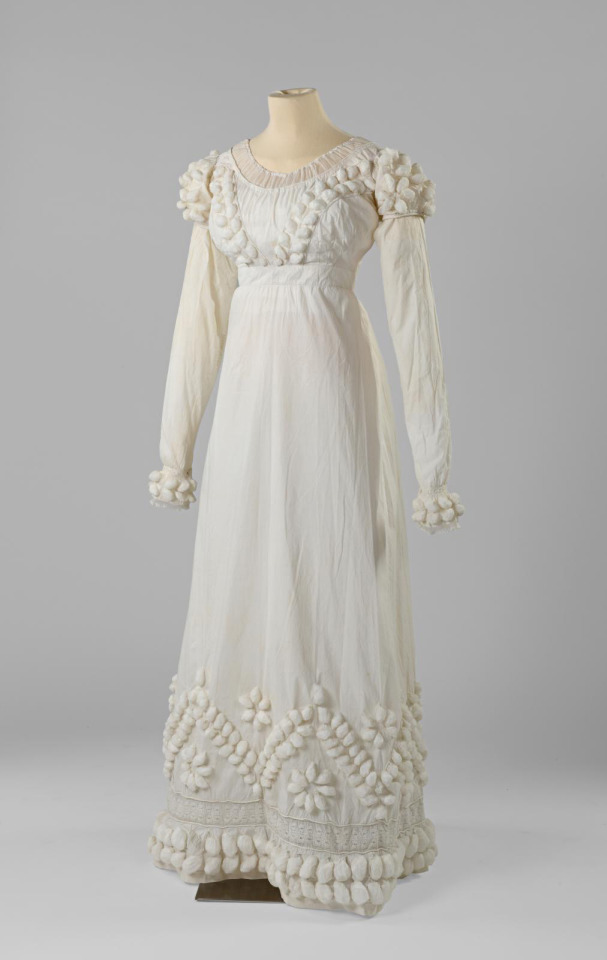
Neoclassical dress, First French Empire, Napoleonic era, c. 1810, white cotton and muslin. (La Gazette Drouot)
#dress#neoclassical dress#empire#empire style#fashion#cotton#muslin#empire waistline#first empire#first French empire#napoleonic era#19th century#1800s#1800s fashion#French#France#French fashion#fashion history#historical fashion#history of fashion#neoclassical#neoclassicism#costume#regency#regency fashion#Jane Austen#napoleonic
192 notes
·
View notes
Text
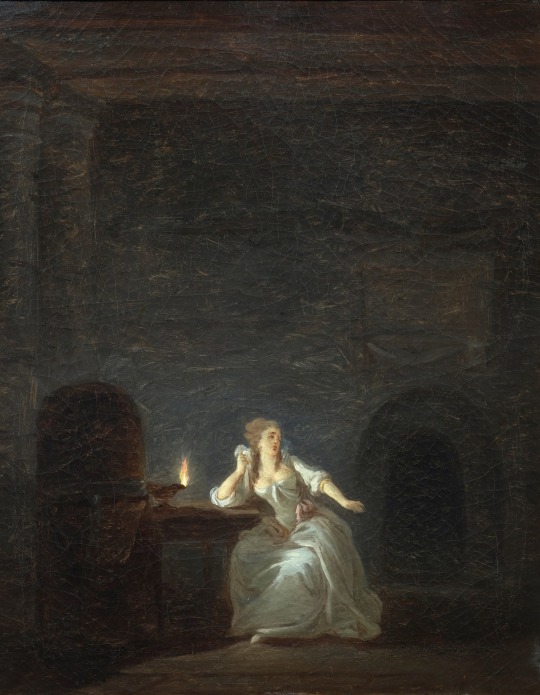
The Torture of the Vestal Virgin by Jean-Frédéric Schall
#jean frédéric schall#art#vestal virgin#roman#priestess#ancient rome#condemned#imprisoned#dungeon#dungeons#france#ancien régime#the terror#the reign of terror#history#europe#european#vestals#priestesses#despair#dress#handkerchief#oil lamp#elegant woman#lamp#light#dark#darkness#neoclassicism#neoclassical
211 notes
·
View notes
Text
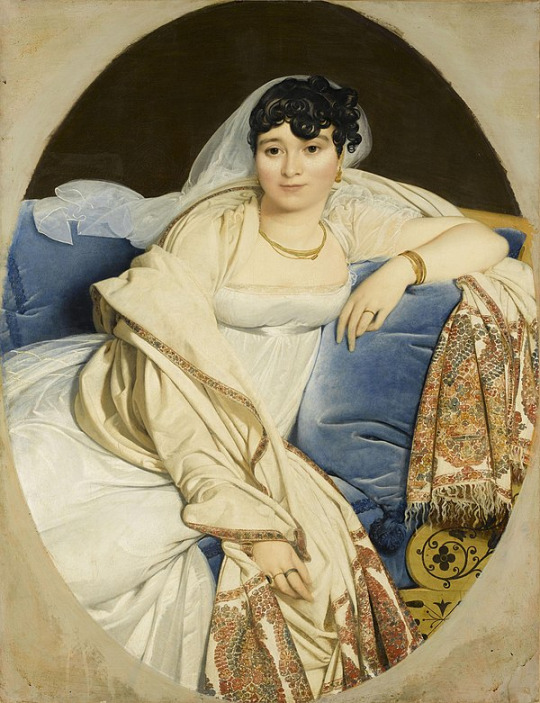
Jean Auguste Dominique Ingres (French, 1780–1867) • Portrait of Marie-Françoise Rivière • 1805–06 • Musée du Louvre
#art#painting#fine art#art history#jean auguste dominique ingres#french artist#neoclassical painting#portrait#female portrait#19th century european art#musée du louvre#white dress#la robe blanche#women in white#french painter
9 notes
·
View notes
Text

Aglaia: the journal of the Healthy and Artistic Dress Union
By Health and Artistic Dress Union, 1894
Archive.com
#1890s#fashion#1890s fashion#fashion history#historical fashion#england#artistic dress#outfit inspiration#ootd#portrait#19th century#victorian#neoclassical
4 notes
·
View notes
Text
What if this is just my summer of greco-roman drapery?
#forget the rest of my dress shopping#it's looking like a girl in a neoclassical painting time#one of those lawrence alma-tedema girlfriends
3 notes
·
View notes
Text
CORRECTED & UPDATED! Clothes + Equivocation = Romance:
The Husbands in 1793
EDIT: I made a significant error when I wrote this. As @goodjomans kindly points out in the comments to Part 2 of this essay (massive shoutout for this, goodjomans! also I love your name!), Aziraphale is the one who dresses the executioner in clothing like Aziraphale's original ensemble, not Crowley. This changes my conclusions about the meaning we can take from this scene!
On the one hand, mea culpa, y'all. I shall get on with eating my crow. On the other hand, I had to go through this frame-by-frame to catch which of the ineffable spouses puts Jean-Claude in his new togs, and the answer only lasts three frames. Here it is:
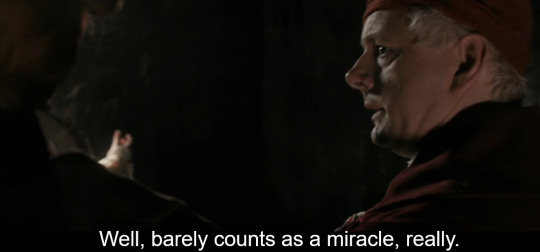
After Aziraphale changes his clothes, but before Crowley snaps his fingers and unfreezes time, there's a shot of the executioner over Crowley's shoulder, and he is now wearing a light coat with gold embroidery on the shoulders like Aziraphale's. Aziraphale arranges the executioner's death, not Crowley. So I feel like an idiot for missing it, but not a total idiot.
Let's discuss how this information changes what we can read from this scene! I'm going to leave my original text in place and edit with bold green. I can still stand by most of this essay, but this detail changes how I read the meaning of the husbands' communication at the end of this scene.
So we're all clear on the fact that the universe of Good Omens is an inescapable nightmare dystopia in which either of the husbands' merciless authoritarian regimes could be watching or listening to them at any time, yes? And that if either are caught 'fraternizing' with the other that means discorporation, torture, memory wipe, and/or death for either or both of them, yes?
Which means Crowley and Aziraphale can never speak or do anything openly to each other about their friendship or attraction or love. Everything they say and do has to have an innocuous meaning they can point to in case anybody ever sees or hears something Team Azcrow can't explain away. Walls (and ducks) have ears, and the price of slipping up--as we see in 1827--is heavy.
When a character says or does something that has two distinct meanings because they need to disguise what they really mean from one party but make their meaning plain to another, lit-nerds (and lit nerds🍃) call this equivocation. Equivocation is a kind of coded communication meant to pass hostile ears and eyes in plain sight but reach its intended recipient with its true meaning. The 1793 scene is jammed with it.
A lot of that coded messaging revolves around the clothes Crowley and Aziraphale choose in this scene, so--THESIS PARAGRAPH, BITCHES--we're going going to talk about how their clothes read to the people of this time period and location, what their clothes tell us about their characters, how their clothes help them equivocate, and what they're really saying with that equivocation. And Spoiler A-fucking-lert, it is ROMANTIC AF PRETTY GD ROMANTIC. Let's get nerdy!
We start with Aziraphale's beautiful champagne-gold and powder-pink ensemble.


This outfit would tell people of this time period 3 things about Aziraphale:
That he's insanely wealthy--These clothes would be silk, hand-embroidered with thread made with actual gold. Each individual garment could cost years' or even decades' worth of working-class wages and take a team of skilled artisans dozens to hundreds of hours to make.
That he's a fop--i.e., a man who loves fine clothes and dressing up and looking fancy. By the 1790s in England, once-fashionable foppishness was giving way to the Neoclassical 'Corinthian' style, and was considered effete. (Fun note: During this time period, effete did not automatically indicate gay, and pink was considered a masculine color, so while Az. is queering it up to the audience here, his clothes would not have read as gay or overtly effeminate to the other characters around him.)
Even though he's insanely wealthy, Aziraphale wears clothes that are decades out of fashion.
According to the Victoria & Albert Museum, "As the [18th] century progressed, the male silhouette slowly changed.[...] Coat skirts gradually became less full and the front was cut in a curved line towards the back. Waistcoats became shorter. The upper leg began to show more and more[...]. Shoes became low-heeled with pointed toes and were fastened with a detachable buckle and straps or ribbon[.]
Source
That description is not what Aziraphale's wearing. Judging by his heel height and the length of his waistcoat, Aziraphale is wearing a style that's at least a decade older than this:
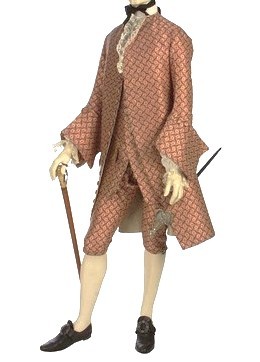
And this is from 1765. The great crepes caper happens in 1793, almost 30 years later.
My inference: Just as he has in the modern period, Aziraphale has settled into a style he really likes and refused to let go of it long after it's gone out of fashion.
We'll come back to this set of Aziraphale's clothes in a bit, but we need to talk about Crowley's first, because Crowley's clothes in this scene help render a line he says later about this outfit very flirtatious and darkly romantic.
First, some background: What was considered acceptable attire for wealthy people in France changed pretty much overnight during the French Revolution after the storming of the Bastille in 1789 and the fall of the French monarchy. Instead of advertising wealth, clothes now had to advertise political allegiance, and they had to do so loud and clear. And if you didn't want to be murdered by the French First Republic, that political allegiance had fucking better be to the Revolution.
People started wearing a looooooot of super patriotic shit. And I mean it was like little kids on the 4th of July; clothes were red, white, and blue in any hue and garish combination and print. The cockade, a fabric rosette in the colors of the French flag, was required by law to be worn by men, and despite that was just as popular among women. To show solidarity with the laboring classes, the fabrics the wealthy wore went from embroidered silk in light Rococo colors (what Aziraphale is wearing) to sober neutrals without decoration in wool, cotton, and linen.
Now, the script note for Crowley's clothing in this scene is this:

But clearly there were some changes made between script and filming, because Crowley does not appear standing behind Aziraphale; he appears lounging.
And he's not dressed as a French peasant.
Here's how French peasants dressed in 1790:

Peasants at this time wore styles that distinguished them from the styles of the upper classes not just in materials, colors, or patterns, but in shapes. Full trousers and cropped boxy jackets in French flag colors were the marks of the laboring-class Revolutionary, and both styles were huge changes from hundreds of years of French fashion up to that point.
And that's not what Crowley shows up wearing. Crowley is wearing the knee breeches, stockings, waistcoat, and frock coat of a wealthy man, and in fact his clothes reference a very specific type of wealthy man.
In the 1790s, if you were an aristocrat who wasn't happy about the Revolution and you were so sure of your privilege that you would risk your life showing it, you wore black in mourning for the monarchy and in protest of the violence of its deposition. If you were an aristocrat who wanted to protest and you didn't want to be immediately murdered by the French First Republic, you wore a style called half-mourning, which was black with a colored coat.
Here's a picture from a 1790 fashion magazine of an aristocrat in half-mourning:

"The text accompanying the plate describes his ensemble as 'half-mourning,' referring to the aristocrats who lamented 'the diminished powers of the monarchy and [signaled] their willingness to die for the royal cause'" [emph. added]. [Source]
Notice: the shoes, stockings, breeches, waistcoat, and cravat are all black. You with me?
Because here's Crowley in 1793:

I've turned up the brightness and exposure in this image so he's more clearly visible against the stone, but I haven't warmed it up. He's wearing a coat that's a dark blackish red. Everything else, even his cravat, even his shirt, is black. (The black shirt is anachronistic, a lovely little nod to Crowley's refusal to wear angelic white.)
This is 179fuckin'3, y'all. Marie Antoinette is executed in 1793. It's 3 full years after that fashion plate up there in his bright red jacket, and that lil dude was already risking his neck way back in 1790. As we can see from the fact that the government are apparently now grabbing random wealthy-looking Englishmen off the street to murder without trial, the time for a man demon to be sauntering around Paris dressed in all black or even nearly all black is well past.
Crowley's also wearing a whole assload of huge silver buttons, which would have been flashy and tacky and frankly pretty weird in 1793 but very definitely an eccentric Rich Person Thing to do, bc regular buttons at this time were horn or wood and covered with the garment's fabric. The only man in France who could get away with this fancy aristo shit anymore was Robespierre himself, and only "devotion to the cause[...] excused Robespierre’s showy dress since he was perceived as a bridge between the politically empowered bourgeois deputies and the ardently antimonarchical unenfranchised classes." [Source]
So when Crowley teases Aziraphale--
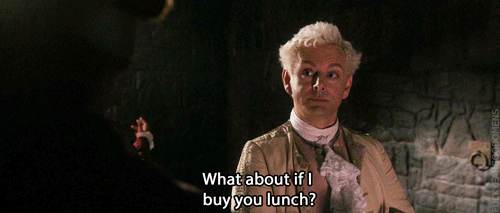

--both of them are perfectly well aware that Crowley's outfit would get him just as killed as Aziraphale's.
And that's why Aziraphale's expression is annoyed when he has abandon his "standards" and change his clothes. Because Aziraphale's the one who needs the favor, Crowley makes him take one for the team and wear the goofy hat.

The clothes Az. changes into here still tell people that he's rich, but they also say he's a hardcore Revolutionary. The red jacket in a current cutaway style, the cockade and sash, and the bonnet phrygien (the red garden-gnome cap) all announce this guy is a huge supporter of the Revolution. His clothes are all still aristocratic in shape and materials (and he keeps his now-unfashionably frilly lace cravat), but he's no longer flaunting obscene wealth in a city filled with angry starving people, and the gnome cap says he's in solidarity with the working classes even if he isn't one of them.
Once he restarts time, Crowley is not leaving that prison cell safely without either changing his clothes or taking Aziraphale with him, because Crowley looks like a rich asshole protesting the fall of the monarchy--which is frankly exactly the kind of thing he'd show up wearing to the Bastille during the Reign of Terror (just like he wears athleisure in Heaven). But Aziraphale's new appearance covers for them both: if the rich-looking guy with no cockade and wearing all black under his almost-black coat is in with this other guy who's obviously a Revolution fanatic, then the rich guy's probably okay, right? He just forgot his sash at home or something. Bees.
Something else happens when Az. changes, too. Look at Aziraphale's new dress from a different angle:
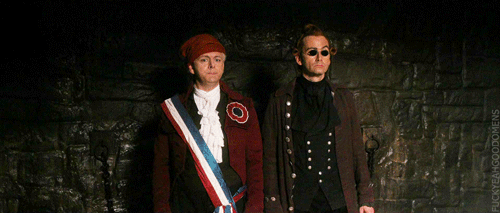
Half-mourning is a white shirt, but a black cravat, so this isn't half-mourning. He's wearing three different badges of the Revolution to make up for the fact that Crowley looks like a Satanic libertine (which tbf he is), but Aziraphale's new ensemble is black and dark red.
Y'all. Aziraphale changes into Crowley's colors.
Now, this is a more fashionable and higher quality version of what the executioner is wearing, so Aziraphale has very plausible deniability here; if anyone ever pulled him up on it, he could say he just copied our man Jean-Claude.
But let me show you what English fashion looks like right now:
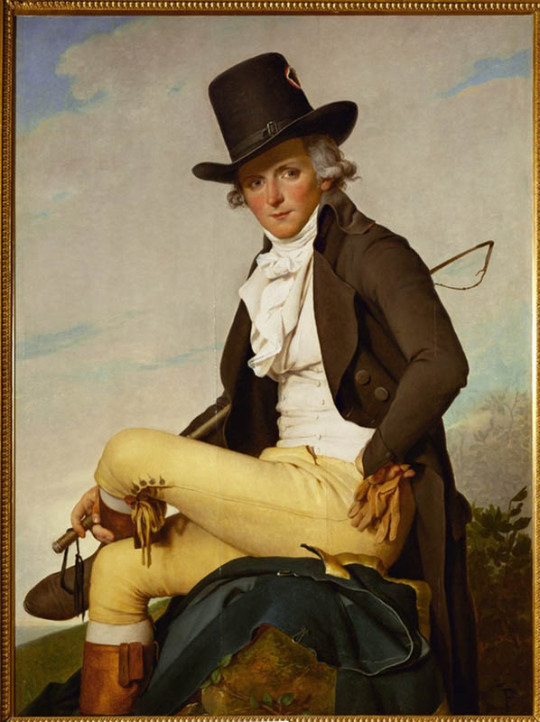
This is a French painting of a wealthy Frenchman, but he's wearing the English 'Corinthian' style. It was painted in 1795, so this would have been the very cutting edge of fashion in England in 1793, and the fabrics and colors look right at home in Revolutionary Paris. (He's wearing the cockade on his hat, btw.)
Look at all that angelic white! The buttery almond of the buckskin breeches, the golden kidskin gloves, the rich tan of the riding boots! The blue of the greatcoat! All colors we know Aziraphale prefers!
And yet this is what Aziraphale chooses:

We know from the entire rest of the show how very particular about his clothes Aziraphale is. And yet 150 years before he (accidentally) admits in words that he's Crowley's friend, Aziraphale wears Crowley's colors to take him to lunch to say thank you for a rescue.
When we decide whether a character's speech or action is equivocation, one of the things we check is whether equivocation (and deception generally) is something that character does elsewhere in the text, which, with Aziraphale, hahahahaha, DUH. He's already using equivocation in this scene.
The lunch date itself is equivocation on Aziraphale's part. Aziraphale tries to thank Crowley for the rescue, but Crowley says,
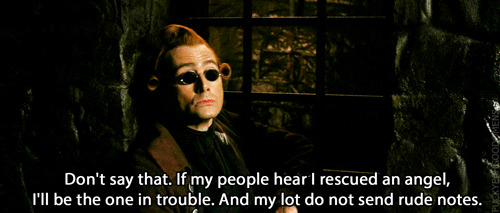
So Aziraphale says,

No more words like "thanks" or "rescue" used, but a couple hours of good food and drink and conversation, Aziraphale hopes, will express the gratitude toward Crowley it's not safe to speak aloud. With this, Crowley and Aziraphale explicitly establish that they are equivocating for each other's safety and using coded communication--immediately before Aziraphale changes into Crowley's colors.
So yes, Aziraphale may well copy the executioner's clothes. But consider: When a character who can't speak or act openly says or does something that has two or more possible meanings, this can be read as equivocation.
We don't get a face reaction from Crowley about Aziraphale's new 'fit, so we can't be sure how he feels about this. But this whole scene is, even on its surface, about 1) the meaning clothes transmit to a viewer ("Oh good Lord," says Aziraphale when he sees what Crowley's wearing) and 2) how to show gratitude and appreciation when you can't speak of them openly. And we know Crowley notices clothing and clothing colors, because look at what he wears, like, ever. So it's very reasonable to presume he notices Aziraphale wearing his colors, and it fits well with both the rest of Crowley's actions in this scene and with his being very hurt and angry when Aziraphale later characterizes their interactions as "fraternizing."
Right, so we've covered what's going on with the husbands' clothes, and we've looked at two examples of equivocation on Aziraphale's part, viz., lunch and his change of colors. (Here's an example of equivocation on Crowley's part as well.) Now let's look at that super interesting thing Crowley says about Aziraphale's first outfit.
Here's the line:
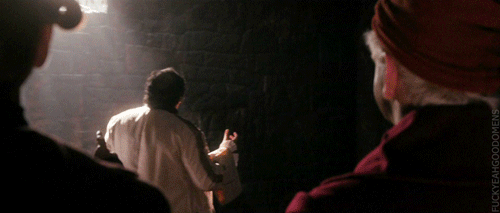
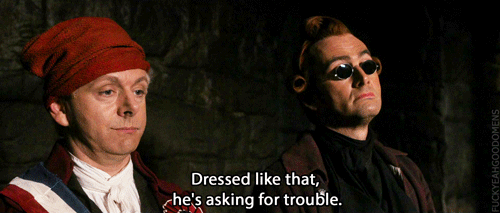
Crowley follows up here on earlier lines in which he teases Aziraphale for coming to Reign-of-Terror Paris for crepes: "Dressed like that?" meaning Aziraphale was guaranteed to get arrested dressed like an aristocrat. The top layer of equivocation is always an innocuous meaning: the plausible deniability meant for the hostile/unsafe listeners. That's Meaning 1.
But "Dressed like that, s/he's asking for trouble" means two other things, too. It's a veeerrrrry familiar phrase, isn't it? We've all heard that arrangement of words in that order before. It's used when people think someone (usually but not always a woman) is dressed to invite sexual attention.
How do we know we're supposed to take this modern meaning from this phrase? This is how:

We have learned in literally the previous sentence to this one that rain has not been invented yet. The only two humans in existence have just left the Garden. Balloons definitely do not exist yet, humans couldn't tell you what lead is, and yet this is a phrase Crowley uses and Aziraphale understands. This tells us, the audience, in the very first line of the very first scene with these characters, that their speech is anachronistic and modern, and that we are to understand their phrasing in its contemporary sense.
So. When Crowley says "Dressed like that, he was asking for trouble" in 1793, we should read that in the context of the scene and in the senses the phrase carries to us today.
And since Crowley is using a phrase that means the executioner is dressed to invite sexual attention, and the executioner is wearing clothes identical to Aziraphale's, then Crowley is necessarily telling Aziraphale that when Aziraphale was wearing those clothes--those frilly, effete, unfashionable-for-decades clothes that nobody else likes and the French now murder people for wearing--that was, in Crowley's view...provocatively sexy. Meaning 2.
"Dressed like that, s/he was asking for trouble" is also what people say to justify violence, especially sexual violence against women and queerphobic attacks against men perceived as gay or just 'insufficiently' 'masculine'. In fact justifying assault is likely the most common way this phrase is used today by a wide margin. Meaning 3.
Crowley's joke isn't even really a joke in this sense; it's a vicious barb. And, because it must, it sounds like it's at Aziraphale's expense: You wore the wrong clothes, you weren't careful enough to guard yourself against the men who want to do you harm, so you deserved the trouble you got. Meaning 1.
Except remember: Crowley is also dressed for trouble. And Aziraphale is aware of this. Crowley's 'fit would be almost as offensive to the Revolutionary French of 1793 as Aziraphale's Rococo pastels, and probably just as likely to get him arrested and murdered by the state if he weren't making letting Aziraphale keep him safe by wearing the cockade and the silly hat. Crowley's not saying anything about Aziraphale here that he's not also saying about himself; and as we know from Aziraphale's initial "Oh good Lord" when he turns around and sees Crowley's black and red half-mourning (with extra black and gobs of silver), Aziraphale knows it.
Then why the rapey joke, Crowley?
This is fucking why:
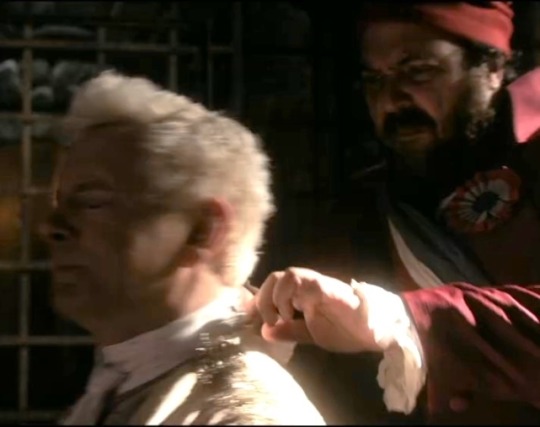
Crowley rocks up at the Bastille just in time to witness some grubby fucker assault his friend. Assault the person Crowley will greet 15 seconds after this as angel.
Crowley's first act after freeing Aziraphale is to send this dude to his death. Nope! Aziraphale is the one who arranges to have the executioner killed in the clothes he would have killed Aziraphale for wearing. He takes Jean-Claude's ability to speak (but not to make sounds, interestingly! Jean-Claude can still whimper, Jean-Claude can still cry!) so the executioner can't tell anyone about the 'mixup.' It's unclear which of them blocks the executioner's power of speech. The vicious joke about assault in Meaning 3 isn't at Aziraphale's expense at all. It's not You wore the wrong clothes, so you deserved the trouble you got. It's If this guy thinks you deserve trouble for wearing the wrong clothes, he can eat his own rules.
And that's the other piece of evidence that, along with Crowley's ensemble, shows us the audience and Aziraphale which meanings Crowley intends with his equivocation. Meaning 1 is cancelled out by Crowley's clothes. That leaves Meanings 2 and 3.
Crowley and Aziraphale share clothes as a common interest. They don't have the same style, but they're both aware of current fashions, and Heaven and Hell aren't. You can't tell me Hastur or Uriel would recognize the significance of Crowley saying "Dressed like that, he's asking for trouble" about someone else while wearing black stockings and cravat and waistcoat himself. And that means Anything the husbands communicate to each other through clothing choices goes undetected by their masters.
SO. With all this in mind, let's go through the 1793 scene again and look at what their clothes help them say without words.
Concluded in Part 2!
#good omens#good omens 2#good omens s2#good omens costumes#good omens fan theory#good omens meta#good omens analysis#aziracrow#azcrow#ineffable husbands#aziraphale x crowley#azicrow#good omens 1793#good omens 1984#good omens clothes and equivocation
548 notes
·
View notes
Text
Adolescence of Utena -- Architecture x Character Designs
Dunno if I read it from somewhere, but I realized that Utena's new uniform is styled somewhat like the architecture of Adolescence Ohtori, namely how her clothes are black and white (later with red accents) . Whereas Utena stands out in the world of RGU, she blends right into Adolescence Ohtori, almost as if she is a part of the architecture and vice versa.

The movie is also called The *Adolescence* of Utena (or Girl's Revolution Utena: Adolescence Apocalypse), and in the show, we see adolescent Utena wear black and white at the funeral. I think that her wearing this scheme again in the movie is a sort of return to her adolescence. Not to say that she regressed back into the child she was before the show, but more so to represent the child that Utena still is even after maturing. An adolescent is defined as someone roughly between 10-19; Utena is still a teen who's growing in this age range.
That said, Adolescence Ohtori seems to be an architectural representation of Utena's inner child/self. Like a mindscape of sorts. At the end of the movie, both she and Anthy would leave the mindscape of their adolescence and enter into the unknown "outside world" of adulthood.


Red is associated with the Rose Bride, ie Anthy. Before meeting Anthy for the first time in the show, Utena's clothing was absent of red (her child funeral dress); however Utena's RGU uniform afterwards would have red accents.
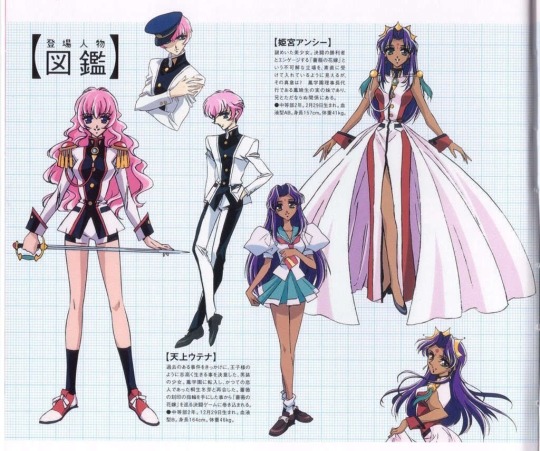
Similarly, Utena's Adolescence "boy" clothing doesn't have red, but her "prince garb" after meeting Anthy does.
Speaking of, if we continue seeing Ohtori as Utena's mindscape, the deep red of the Adolescence rose garden is like the part of Utena's mind that Anthy occupies. The tower where the girls draw is also Anthy's domain, as it's draped in red.

Even other black-white architecture of Ohtori is accented with red--Anthy has always been present in Utena's thoughts, even if subconsciously.

Alternatively, red in Ohtori could represent Anthy's mindscape "overlapping" with Utena's. Anthy is still wrestling with leaving Akio after all, and after the events of RGU, it would make sense that she and Utena share "spaces"/experiences/solidarity.
Anthy's Rose Bride dress also more closely resembles Utena/Ohtori's aesthetic (white, red with black accents), and we only see her transform into that when she is with Utena. It seems to signify that Anthy has become more familiar/recognizable to Utena, as her Rose Bride dress visually brings her closer to Utena, more so than her generic mint-green uniform.
When Utena first meets Anthy in Adolescence, a light flurry of rose petals fall from the garden above, crossing from Anthy's domain into Utena's-- they are beginning to cross each other's paths again. During the dance in the garden, a much heavier shower of roses blanket the school architecture below, as if Utena and Anthy's connection has now become much stronger. From then on, Utena would try to create a genuine bond with Anthy (as we see during the drawing session)
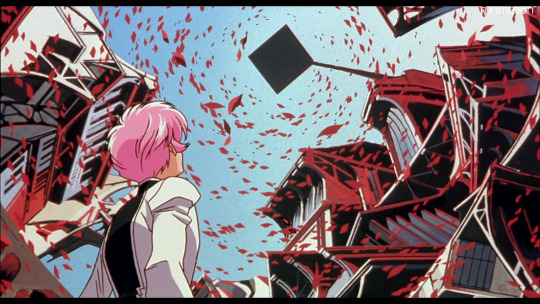

Alternatively, it could also signify a progression towards Anthy taking the spotlight when she and Utena decide to leave the school for good:

Near the end of Adolescence, we are back in Anthy's rose garden, we see the chairman's tower (associated with Anthy and Akio), and everything is washed in purples and reds-- Anthy's colors. Utena's black/white structures are now absent. From here on out, Anthy is going to drive (heh) the story forward.
I wanna talk about the architectural styles of Ohtori, but that'll be its own post once I do a bit more research. I wanna expand on some differences such as:
Adolescence- constructivist, Russian Revolution, industrial, "masculine"


Show- neoclassical/rococo? French Revolution, floral/decorative, "feminine" -- perhaps Anthy's mindscape in a way.


Anyway this was supposed to be a bullet point list of miscellaneous stray thoughts, but I guess that's impossible, so I'll just eventually write more individual utena thoughts posts lol
Please feel free to tell me what you think btw!
There's also another post by @nothing-suspicious-in-there about Utena's uniform that's a completely different take, please check it out!
#utena thoughts#uniform#architecture#ohtori#rgu#shojo kakumei utena#sku#adolescence of utena#anthy himemiya#utena tenjou#akio ohtori#analysis#design#character#rgu analysis#revolutionary girl utena
591 notes
·
View notes
Text
Damn this beauty ❤️🖤🧡 my Gloria Regali - Daenerys Targaryen, the Dragon Queen in Westeros 🔥

Plus some sketches I'll color & add later - the general theme being her fashion when she comes to Westeros and rules there. This one up there ☝️ is her after more than ten years, when she's thirty years old.
The others are
1) When she's just back (17-18 at the oldest) and getting used to a different style

Inspired by this beautiful Dior dress fashioned after a greek column (given that for me one of the Valyrian style is inspired by the greek style of dress). A tie between the old and the modern.

2) When she's twenty & settled
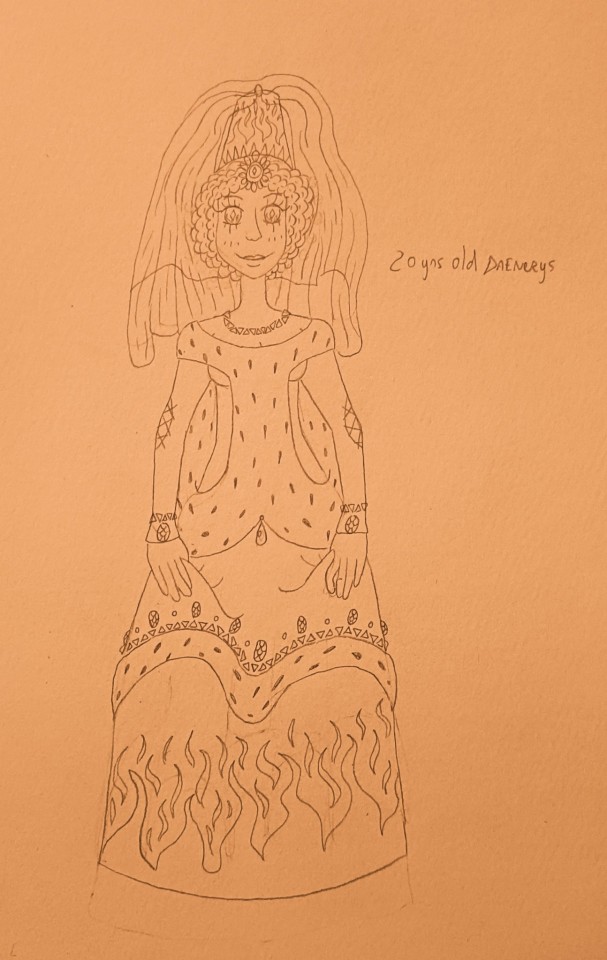
Loosely inspired by this dress 👇 (very fond of Dany in hermine & middle ages european regal outfit)

3) When she's twenty five :
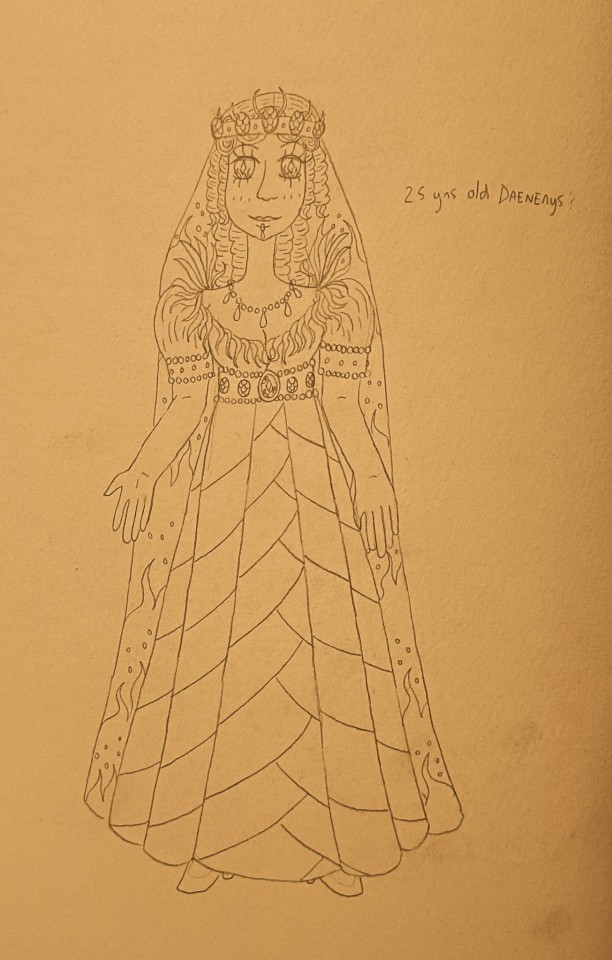
Inspired by these kinds of outfits (Daenerys in Empire Clothing, especially Empress Josephine's, is also a must, with that neoclassical vibe).

54 notes
·
View notes
Note
I was very pleased with my English 1820s man. I made sure he had enrichment of a scholarly nature, to balance out the Romantic tendencies they have. He took to studying classical history and language, and I confess I was proud to have such an intelligent 19th century man. More recently he took an interest in current affairs but, as he is quite young, I assumed this was a sign of maturing. Then, just like that, he ran away! I went out searching and a neighbour informed me that he'd gone to Greece to fight against the Ottomans! I was horrified and went straight there, but I found him with a pack of Greek 1820s men and he adamantly refused to come home. What should I do? I worry that he will get hurt fighting, or that his constitution will not survive rough living in the Greek mountains. But he's having such a good time. He is learning the modern iteration of Greek (such a clever man), enjoys the local cuisine, and even wants to dress like his new friends. Is he in great danger if I let him stay, and how could I take him home without breaking his heart? (I don't want to risk any of those Greek 1820s men getting angry either, if I take their lucky mascot away.) Many thanks for your advice!
Romanticism and nationalism make for a very potent combination, as you have learned by now, and for many 19th century men of a certain social class and level of education, the attraction of the Classical world adds another layer of mythical folklore; not to mention the allure of pagan ceremony and skimpy neoclassical clothes.
For 1820s-1830s men, the Byronic appeal of exotic "Eastern" nations can be irresistible, and in general you will find a lot of national myth-making and interest in folk costumes.
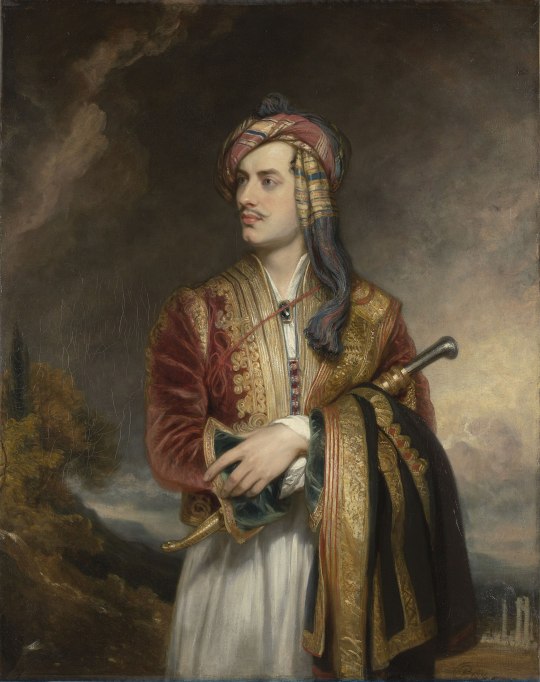
Lord Byron in Albanian dress, 1813. This man is not Albanian!
You also have to be aware of your 19th century man's possibly very different ideas of national and imperial boundaries. He learns the polka in Bohemia, he wants to fight the Ottomans, he wants to fight in the Miguelite war—he might support Romantic German nationalism! It's not always the national and cultural understandings of the 21st century.
Being British is also not a guarantee of sensible behaviour. You might think that your British naval officer is going to rest on his laurels after the Napoleonic Wars, and the next thing you know, he's leading a fleet in the Chilean Independence movement!
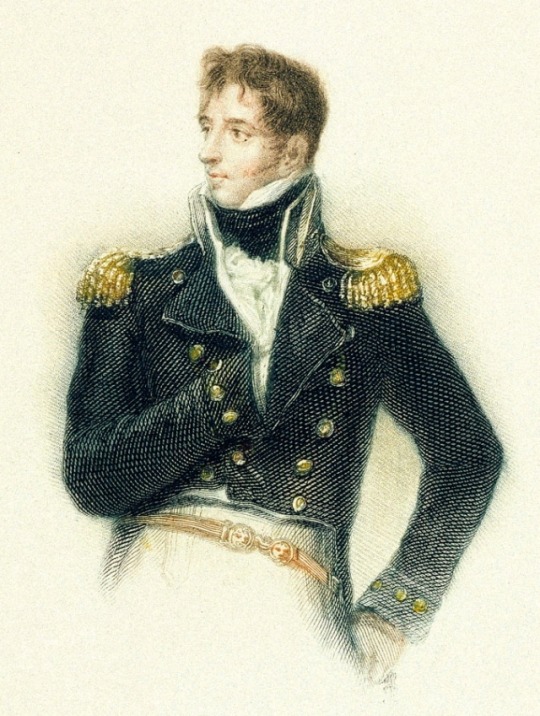
Thomas Cochrane, naval officer for hire.
19th century men are not for the faint of heart. It can be challenging to balance their Romantic desires with a sensible course of action. Since your man has already spent so much time with his new Greek friends and has embraced their lifestyle, you could suggest that it's important that he document his experiences in a travel narrative that will also champion their cause.
As much as possible, you want to convince him that he's very valuable as a writer and/or visual artist giving voice to a cause—too valuable to foolishly risk his life or ruin his health abroad.
#is the 19th century man okay#asks#romanticism#nationalism#1830s#1820s#more problems caused by lord byron
129 notes
·
View notes
Text




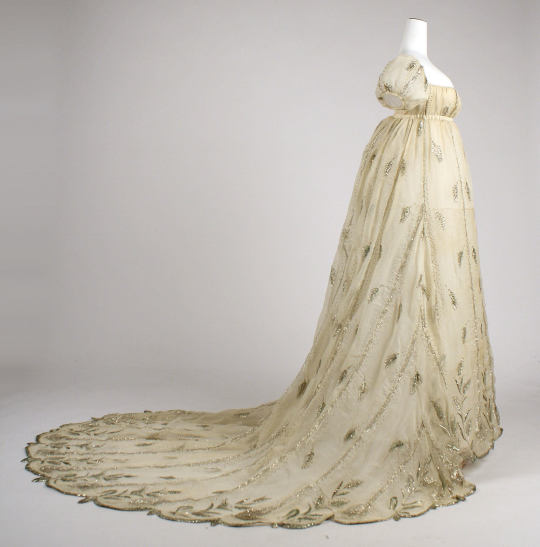
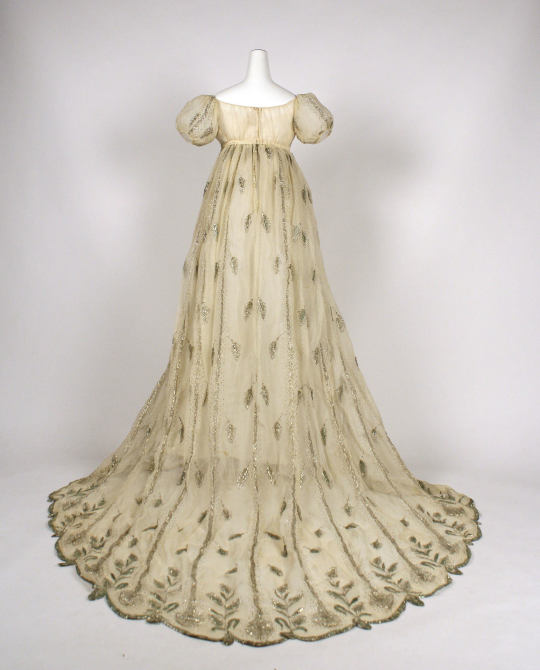
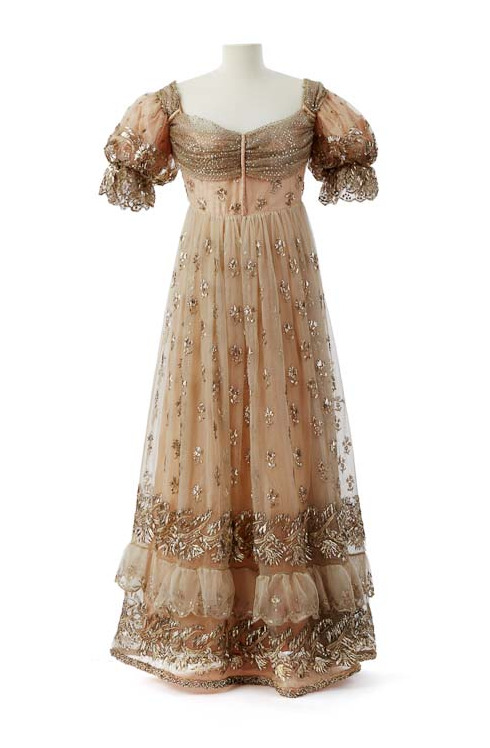

Some of my favorite Empire Style dresses from France in the early 19th century
Town dress with chemisette owned by Empress Josephine, First Empire, circa 1804-1809 (Château de Malmaison) / Dress, 1805-1810 (The Met) / Evening Dress, 1805-1810 (The Met) / Court dress attributed to Empress Josephine, after 1810 (Château de Malmaison)
#empire style#french empire#first french empire#fashion#french fashion#napoleonic era fashion#napoleonic era#empress josephine#early 19th century#historical fashion#malmaison#regency#french art#pretty#dresses#the met#romanticism#neoclassical
795 notes
·
View notes
Text

Lucien Bonaparte contemplating his mistress, Alexandrine de Bleschamp Jouberthon by Guillaume Guillon-Lethière
#lucien bonaparte#bonaparte#art#guillaume guillon lethière#alexandrine de bleschamp jouberthon#alexandrine de bleschamp#madame jouberthon#portrait#france#french#napoleonic#neoclassical#neoclassicism#europe#european#antiquity#antique#dress#venus#roman#greek#history#incense burner#sofa#chair#busts#romantic#romanticism
89 notes
·
View notes
Text

John William Godward (1861-1922)
"Lesbia with her Sparrow" (1916)
Oil on canvas
Neoclassical
Currently in a private collection
#paintings#art#artwork#literary painting#female portrait#john william godward#oil on canvas#fine art#neoclassical#neoclassicism#private collection#english artist#british artist#dresses#costume#costumes#birds#sparrow#animals#interiror#ancient rome#1910s#early 1900s#early 20th century#aesthetic#asesthetics
337 notes
·
View notes
Photo
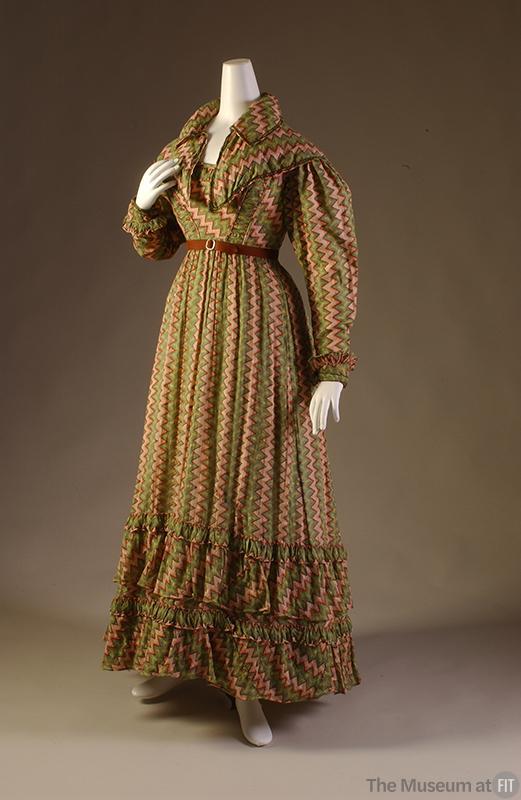

Afternoon Dress
c.1821
England
By the 1820s, multicolor, patterned garments had begun to replace the gossamer white of the century's first decade, due in large part to new developments in printing technology. Textile manufacturers were able to mechanize and economize production using engraved rollers rather than traditional wood blocks or copper plates. This dress, with its soft-colored zigzag pattern embellished by ruffles and braid, is very much a transitional piece that illustrates the move from the neoclassical mode to the more romantic styling of the 1820s and 1830s. From the previous decade, the dress retains the elevated waist. Other features - the blousy sleeve and the pelerine collar - are fashion points that would become increasingly prevalent and exaggerated in the 1830s. (Museum at FIT)
Museum at FIT (Object number: P83.32.2)
#afternoon dress#fashion history#historical fashion#1820s#19th century#empire era#regency#romantic era#1821#green#pink#cotton#england#united kingdom#up close#museum at fit
276 notes
·
View notes
Text
Neoclassical Gown
1790s
White Muslin
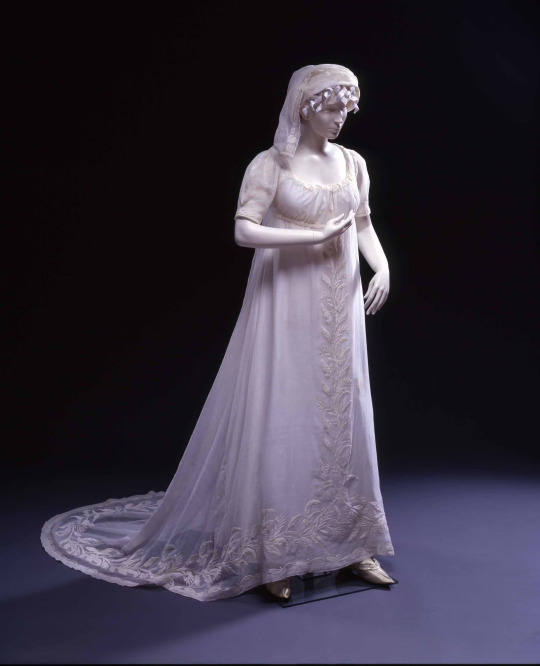
Neoclassical or “antique” style gowns were part of a broader revolution in style that was meant to echo the radical political changes of the American and later the French Revolution. Like Neoclassicism in buildings and art, these white chemise dresses mimicked the fashions of the ancient Greek and Roman republics – lightweight, high waisted, and short sleeved.
It is possible that this gown was sewn by Catharine “Kitty” Livingston Ridley, the daughter of Susan French Livingston and New Jersey Governor (1776 –1790) William Livingston, in Trenton, New Jersey.
The most likely owner of this dress is Eleanor Armstrong, daughter of Susanna Livingston and James Francis Armstrong. Born in 1785 in Trenton, New Jersey, Armstrong married in 1803 at the age of 18. This may have been her wedding dress.
The Daughters of the American Revolution Museum, Washington DC. Gift of Mrs. Anne Glover Anderson.
59 notes
·
View notes
Note
Not to be rude or invasive or make y'all uncomfortable or anything, but where do y'all sleep? It's just that I know that Lithuania and America have slept in the same bed before.

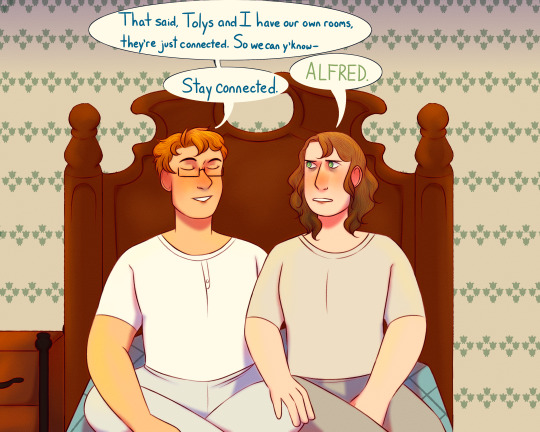


Tolys: I'm used to sharing a space anyway, so I didn't mind when I moved in! It's convenient for everyone I suppose.
**Historical Note: Alfred has kept this home since the 1840s-1850s, a little before Molly came to the United States again. He did this because of the upheaval at the time near Washington D.C. and the personal convenience of living in New York. If D.C. is America's head, New York City is its heart after all.
There were a variety of architectural styles becoming popular at this time such as Italianate, Neoclassical, Georgian Revival, Beaux-Arts, and Gothic Revival. Many of the large homes built in New York City by the newly wealthy around this period were in the Beaux-Arts and Georgian Revival styles. I picture Alfred's home being in the Georgian Revival style like the Carnegie Mansion or the Willard D. Straight House.
Alfred's home is certainly downsized from the scale of these mansions, but has many of the rooms typical of an upper-class home of the late 19th-early 20th century. These homes were typically three to four floors, with the first floor being for entertaining company and for leisure. The reception room was for receiving guests and leaving calling cards if the homeowner was not available, while the drawing room was for entertaining guests or for the family to relax in. It was also typical for these homes to have a small-scale dining room for less formal family meals such as breakfast and a more formal dining room for entertaining guests in the evening. This smaller scale dining area was also typically where children ate when these evening events were held, and they were usually not permitted at the formal table until they reached their late teens.
Floors for guests to sleep and for the family were often separated, and in many cases the children slept on a separate floor from the adults. In very wealthy homes, there was usually a floor or space reserved for servants' quarters and passages for staff to move around the house in without being seen. In upper-class households, the husband and wife often had separate but connected rooms. This wasn't necessarily out of personal modesty, but more for the modesty of the servants who might be helping them dress. Here, Alfred and Tolys use it more for convenience. In lower-class households, it was still perfectly common and acceptable for a couple to share a room and bed.
There's certainly more that could be said about the layout of these homes, and I based these floor plans off of several historic homes I've visited and floor plans I researched online. Therefore, if there are inaccuracies or if there's anything I overlooked, my apologies!
#hetalia#ask#historical hetalia#hws america#hws lithuania#hws romano#hws ireland#nyo!ireland#ameliet#iremano#aph america#aph lithuania#aph romano#aph ireland#hetalia ask blog#and they were roommates... oh my god they were roommates
57 notes
·
View notes